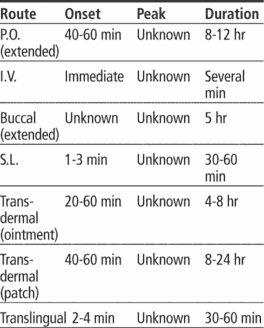Medical term:
Nitrol
nitroglycerin
Pharmacologic class: Nitrate
Therapeutic class: Antianginal
Pregnancy risk category C
Action
Inhibits calcium transport into myocardial and vascular smooth muscle cells, suppressing contractions. Dilates main coronary arteries and arterioles, inhibits coronary artery spasm, increases oxygen delivery to heart, and reduces frequency and severity of angina attacks.
Availability
Capsules (extended-release): 2.5 mg, 6.5 mg, 9 mg
Injection: 0.5 mg/ml, 5 mg/ml
Ointment (transdermal): 2%
Solution for injection: 25 mg/250 ml, 50 mg/250 ml, 50 mg/500 ml, 100 mg/250 ml, 200 mg/500 ml
Spray (translingual): 0.4 mg/spray in 14.5-g canister (200 doses)
Tablets (buccal, extended-release): 1 mg, 2 mg, 3 mg, 5 mg
Tablets (extended-release): 2.6 mg, 6.5 mg, 9 mg
Tablets (sublingual): 0.3 mg, 0.4 mg, 0.6 mg
Transdermal system (patch): 0.1 mg/hour, 0.2 mg/hour, 0.3 mg/hour, 0.4 mg/hour, 0.6 mg/hour, 0.8 mg/hour
Indications and dosages
➣ Management and prophylaxis of angina pectoris
Adults: For acute angina attack, 0.3 to 0.6 mg S.L., repeated q 5 minutes for 15 minutes p.r.n.; or one to two trans-lingual sprays, repeated q 5 minutes for 15 minutes p.r.n. For long-term or prophylactic use, 1-mg extended-release buccal tablet q 5 hours, with dosage and frequency increased p.r.n.; or 2.5 to 9 mg (extended-release tablets) P.O. q 8 to 12 hours; or 1.3 to 6.5 mg (extended-release capsules) P.O. q 8 to 12 hours.
➣ Hypertension during surgery; adjunct in heart failure
Adults: 5 mcg/minute I.V., increased by 5 mcg/minute q 3 to 5 minutes up to 20 mcg/minute, then increased by 10 to 20 mcg/minute q 3 to 5 minutes (dosage based on hemodynamic parameters)
➣ Heart failure associated with acute myocardial infarction (MI)
Adults: 12.5 to 25 mcg I.V., then a continuous infusion of 10 to 20 mcg/minute q 5 to 10 minutes; increase by 5 to 10 mcg/minute q 5 to 10 minutes as needed to a maximum of 200 mcg/minute.
Contraindications
• Hypersensitivity to drug, other organic nitrates, nitrites, or adhesives (transdermal form)
• Angle-closure glaucoma
• Orthostatic hypotension
• Hypotension or uncorrected hypovolemia (I.V. form)
• Early MI (S.L. form)
• Increased intracranial pressure (as from head trauma or cerebral hemorrhage)
• Severe anemia
• Pericardial tamponade or constrictive pericarditis
• Concurrent sildenafil therapy
Precautions
Use cautiously in:
• severe renal or hepatic impairment, glaucoma, hypertrophic cardiomyopathy
• hypovolemia, normal or decreased pulmonary capillary wedge pressure (with I.V. use)
• alcohol intolerance (with large I.V. doses)
• pregnant or breastfeeding patients
• children (safety not established).
Administration
• Administer tablets and capsules with water. Don't crush, break, or let patient chew them.
• For S.L. use, administer under tongue or in buccal pouch; instruct patient not to swallow tablet. For acute angina, give at pain onset. For angina prophylaxis, give before activities that may cause anginal pain.
• For translingual use, spray directly onto oral mucosa. Don't let patient inhale spray. Give at pain onset and as needed prophylactically before activities that trigger angina.
• For transdermal use, apply system to skin site with little hair and movement. Don't apply to distal extremities. Rotate application sites to avoid irritation and sensitization.
• Apply transdermal ointment to skin by spreading prescribed amount over 6″ × 6″ area (using an applicator, not your fingers). Cover area with plastic wrap and tape. Rotate sites to reduce risk of irritation and inflammation.
Know that solution for injection is a concentrate. Dilute with dextrose 5% in water or normal saline solution before giving by I.V. infusion.
Don't mix solution for injection with other drugs, and don't give by direct I.V. injection.
• Be aware that solution for injection is affected by type of infusion set used and that dosage is based on use of conventional PVC tubing. When using nonabsorbent tubing, reduce dosage.
• For I.V. use, administer with infusion pump. Increase dosage in increments of 5 mcg/minute every 3 to 5 minutes p.r.n. to achieve desired blood pressure response. Once achieved, reduce dosage and lengthen dosage adjustment intervals.
Don't give concurrently with sildenafil (may cause life-threatening hypotension).

Adverse reactions
CNS: dizziness, headache
CV: hypotension, syncope
Hematologic: methemoglobinemia
Skin: contact dermatitis (with transdermal or ointment use), rash, exfoliative dermatitis, flushing
Interactions
Drug-drug. Antihypertensives, beta-adrenergic blockers, calcium channel blockers, haloperidol, phenothiazines: additive hypotension
Drugs with anticholinergic properties (antihistamines, phenothiazines, tri-cyclic antidepressants): decreased absorption of lingual, S.L., or buccal nitroglycerin
Sildenafil: increased risk of potentially fatal hypotension
Drug-diagnostic tests. Cholesterol: false elevation
Methemoglobin: significant levels (with excessive doses)
Urine catecholamines, urine vanillyl-mandelic acid: increased levels
Drug-behaviors. Alcohol use, acute alcohol ingestion: increased risk of potentially fatal hypotension
Patient monitoring
With I.V. use, monitor blood pressure frequently. Titrate dosage to obtain desired results.
• With transdermal use, check for rash or skin irritation.
• Monitor patient for angina relief.
Patient teaching
• Instruct patient to place S.L. tablet directly under tongue and hold it there as it dissolves. Caution him not to chew or swallow tablet.
• Tell patient to use drug before physical activities that may cause angina.
• Instruct patient to take drug at pain onset and repeat every 5 minutes for three doses. If pain doesn't subside, advise him to seek medical attention.
• Tell patient not to chew or crush sustained-release tablets.
• Advise patient to apply correct amount of ointment using applicator. Caution him to avoid rubbing site. Instruct him to cover ointment with plastic wrap and tape it, to wash hands after placement, and to rotate sites.
• Advise patient to consult prescriber or pharmacist before changing brands of transdermal system. Different brands may have different drug concentrations.
• As appropriate, review all significant and life-threatening adverse reactions and interactions, especially those related to the drugs, tests, and behaviors mentioned above.
Nitrolingual
A brand name for GLYCERYL TRINITRATE.Latest Searches:
anteorbital - Anorgasmy - anociassociation - ankerite - anitrogenous - anhydration - angiectomy - androgenesis - anconal - anatomical - anachoresis - amphigony - ammonification - aminometramide - aminolevulinic - ameburia - ameboma - ambitendencies - alternifolia - alopecia -
- Service manuals - MBI Corp